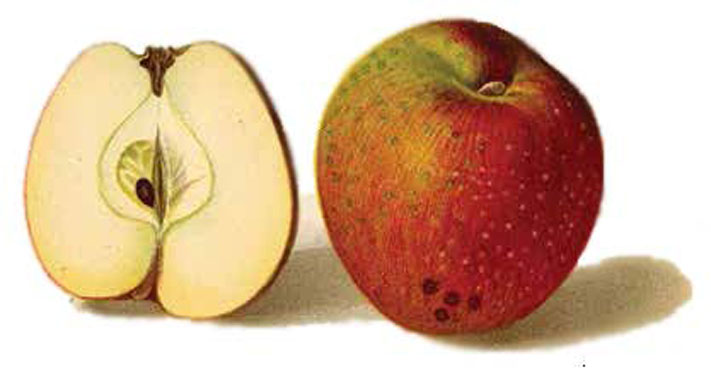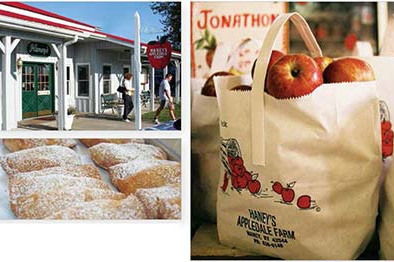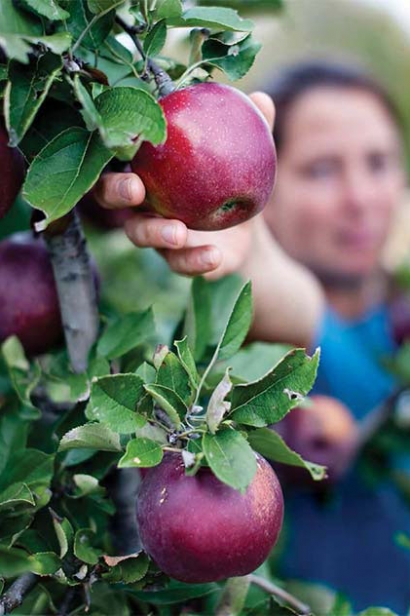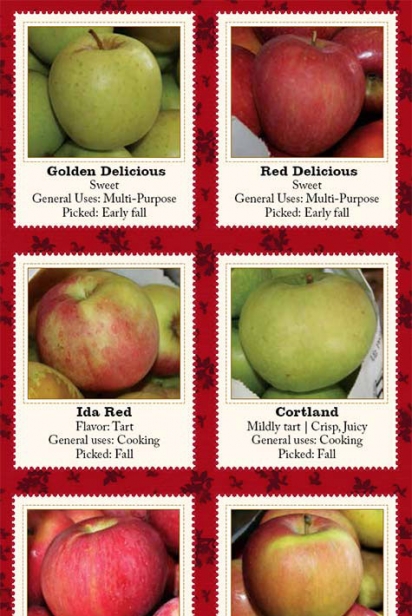Autumn's Crisp Bite
Each Harvest Brings Back Memories to Savor
In the hot, muggy days of August I begin to long for fall, with its foggy mornings and evenings when the sky pales earlier.
Fall always reminds me of apples, pocket-sized memories of my childhood. An apple would be tucked into my school bag from September through winter, its juicy flesh in a convenient package of its own shiny skin.
It pleases me now, in the seventh decade of my life, that I can still make the same trek to Haney’s Appledale Orchard in Nancy, Kentucky, a few miles west of Somerset, as I made with my parents when I was a child. Haney’s has been in the very same place since the late 1800s, making rich memories for folks who come from near and far to pick their favorite apples or rummage through the ready-picked bushels that line the handsome country store, happy to head home with Galas, Fujis, Honeycrisps and countless others for snacking; McIntosh, IdaReds and other tart types for saucing and baking.
Haney’s has been passed down through five generations, the latest owners being Don and Mark Haney, two brothers who were raised on the farm and gained firsthand experience from their late father, Lawrence Haney. Their mother, Oreida, at 89, still holds court with the reputation for her fried apple pies widespread and all her apple recipes in demand.
Mark, who is also president of Kentucky Farm Bureau, explains, “Don and I are beneficiaries of the bequest of our father and grandfather. They knew that planting an orchard would produce fruit to truly span generations. What we plant this year will bear fruit for our grandchildren.
“An orchard is like the life cycle: Our old trees may be bearing their last crops at the same time younger trees are abundant with apples, while our newest plantings are just beginning to spread their roots.
“The orchard requires planning and careful tending, but it is a gift to future generations — our family and our customers as well.”
At Woodland Farm in Oldham County, Laura Lee Brown and Steve Wilson feel the same way about the orchard they planted in 2008, largely to provide fresh apples for the restaurants in their 21c Museum Hotels. Working with their farm horticulturist, Stephanie Tittle, they carefully planted a wide variety of apples, from Arkansas Blacks to Roxbury Russets and heirloom varieties like Calville Blanc d’Hiver an Pomme d’Api.
Wilson, who grew up on a farm in Western Kentucky, explains, “On a farm, apples add balance and harmony to the growing and harvest season. They are not as labor intensive as some plants because their work is spread across the year. Every season has its tasks. The big job of pruning is in the off-season when there’s not as much work in the gardens or out on the farm.
“There is nothing quite like an orchard in bloom in the spring. Come autumn, when the apples arrest you, it’s actually happy work. Unlike tomatoes or peppers, the picking can usually be spread out over a few days, even weeks, without ruining the harvest.”
As I interview the Haneys and Wilson, I am reminded that memory, like apples, can be a slippery thing. Food recollections are the sum of many things, marbled with nostalgia and layers, smells, finishes and aftertastes.
In those fall days of my long ago, it seemed apples were all around us for weeks, their flesh crisp, acid-sweet and full of character for days after our annual excursion to Haney’s.
As soon as we got home, the apples were carefully sorted and any with blemishes were immediately culled. I fondly recall my farmer father taking time out from the fields to help my mother peel these apples as she made them into jellies, preserves and applesauce. The air outside was filled with a scent like cider when she fed the peelings to her flock of Leghorn hens.
Unblemished fruits were wrapped in newspaper and stored in the shallow bins in the cool cellar. We gradually used them for snacks and desserts. Mother was too frugal to discard an apple that had spent too much time in the fruit basket; she just cut out the bad bits and cooked the rest. Alternatively, she diced the remaining good parts into a salad of chicory, celery, raisins and almonds, tossed with her homemade poppy-seed dressing; or she made chutneys to serve with hot curries and meats throughout the winter months. She, who had captured the attention of my father when he was the highest bidder on her apple pie at the Oak Grove Baptist Church Pie Supper in 1929, thought that most of life’s troubles could be soothed with a slice of hot apple pie. Hers, smothered in brown sugar dotted with home-churned butter, and redolent with cinnamon and nutmeg, was tucked into crust made of flour that Wiesenberger Mills had ground from wheat raised on our farm.
By February, everyone was sick of apples, but that too was part of the pleasure. As soon as the fruits began to shrivel in the cellar shelf, they would arrive at the table in a new guise: baked in their skins and dolloped with custard, packed into pies with buttery pastry, stuffed into dumplings with raisins and brown sugar.
All apples taste good when they are baked with sugar and cinnamon. A favorite eating apple might not stand up so well to the rigors of the oven; some apples come from the over tantalizingly colored, nicely shaped with full bodied fruit flavor and aroma. Other emerge faded and a bit slouchy, but tasty nonetheless. With hundreds of varieties, an extraordinary diversity of fragrance, flavor and texture can be found so it’s easy to get your Jonagolds mixed up with your Jonathans.
Each variety has its culinary virtues. The mighty Cortland is the classic cooker — green-skinned, acid fleshed, very grown-up. It melts to a creamy smoothness as a sauce for pork and ham; pectin-rich by itself, it makes beautiful jelly to flavor with herbs. No need for a recipe: simply chop the whole fruit, cook to a purée in just enough water to cover, drip through a cloth overnight and boil the juice with its own volume of sugar until the setting point is reached. Dab a drop on a saucer and push with your finger; when it wrinkles, it’s ready.
The great Granny Smith is a fine fryer. Slice it with the peelings on, caramelize quickly in butter and a little sugar and serve instead of a vegetable with roast meat or chicken. It is beautiful with pork and sauerkraut or any cabbage dish, and a tasty breakfast side with biscuits and sausage gravy.
The vanilla-scented Grimes Golden holds its shape in an open tart and won’t collapse when pushed into the cavity of poultry that needs a moistening stuffing. The Rome Beauty has similar qualities, while the Braeburn is a pie-friendly allrounder. McIntosh completely collapse as their interiors soften and their texture becomes “applesaucy.”
Overall, for baking I prefer the Honeycrisp. Large, super-crisp and sweet-yettangy, it holds it shape fairly well when baked, and its reddish-yellow skin takes on a nice tawny hue. The taste is sweet and mellow.
The range of pleasing flavors and textures that apples possess, from sweet to incredibly tart, tender to snappy crisp, explain why they continue to be the most widely grown fruit on the planet.
When other crops fall on hard times an apple can be a consolation. When other crops stall due to too much or too little rain, an apple tree keeps humming along. A lot of growers vouch that apples are easier to grow in poorer soils than in richer ones. In thinner soils the trees grow slower and are easier to prune and keep within bounds. It’s easy to understand the temptation of apples and how this fruit came to be the great symbolic plant in the Garden of Eden. After all, an apple a day keeps the doctor away.
Oreida Haney shares some favorite recipes.
Oreida’s Apple Muffins
Apple Pan Dowdy
Shenandoah Valley Apple Cake with Caramel Icing
Oreida Haney’s Apple Crisp
Lois Mateus, retired from Brown-Forman, lives and farms with her husband, Tim Peters, at Tallgrass Farm near Harrodsburg.








